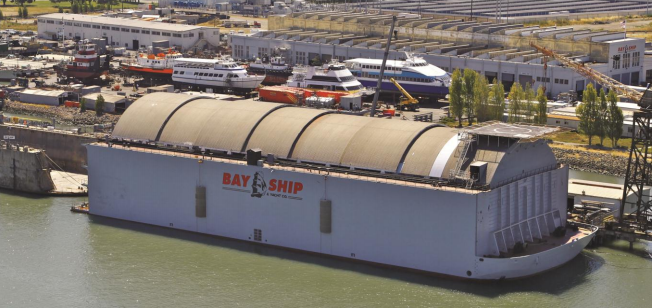We finally got a decent winter storm here in California which meant that instead of my usual train/ferry & bike commute I had to shlep it home on a bus to stay dry. The bus is comfortable but it involves a good 60 minutes so it’s a good time to catch up on podcasts.
Today I listened to a fascinating piece which told the story of the “Glomar Response” which is that foggy response that a PR flack gives when they want to answer a question with a non-response.
“We can neither confirm nor deny. . .”
When did such a phrase come about? What were the circumstances that required someone to come up with such a turn of a phrase? The good folks at Radiolab dug in and found the answer. Give it a listen, it’s an amazing piece of cold war yarn.
Here’s the Alameda connection. A sister ship to the Hughes Glomar Explorer was the HMB-1. This was basically a floating dry dock which had ballast tanks that would flood and submerge the dock underwater beneath the Explorer. Inside was the massive claw device used to grab the submarine mentioned in the story. The sub could then be pulled into the docking bay while it’s still underwater and the HMB-1 surfaced and the retractable roof pulled back over on top, all the while hiding its cargo from the prying eyes of Soviet spy satellites. It’s all very James Bond.
Later, the HMB-1 was commissioned by the Navy for the Sea Shadow, an experimental ship built back in the 80’s when stealth technology was all the rage.

The HMB-1 was designed to hold this top secret boat, again, to keep it from prying eyes between engagements.

The Sea Shadow never was produced and it, along with it’s floating/submersible covered dry dock was eventually mothballed in Suisun Bay north of Martinez.
The Alameda connection takes place several years later when the Navy decides to auction the whole package off.
Even though Bay Ship & Yacht Company would eventually be awarded the vessel, the company’s bid wasn’t the highest. “The highest bidder was a Chinese outfit, I believe,” Cameron said. “Even though the Sea Shadow project had been declassified, there were still some privacy issues, so the government didn’t want to sell her to a foreign entity.
And the second highest bidder, which was a company in the Gulf Coast, backed out when they realized how much it would cost to move her down there. We actually wrote it off as ‘not gonna happen’ when we found out we’d been outbid. Then we got a call a month later letting us know she was ours if we still wanted her.
The $2.5 million price tag was small compared to the $15-$20 million that it would cost to build a new traditional dry dock, which Bay Ship & Yacht had been considering for some time. “And we wouldn’t have that cover, which makes HMB-1 such a strong and unique piece of equipment,” Cameron said. He estimates that to build HMB-1 now would cost upwards of $50 million.
The biggest challenge that shipbuilders and ship repairers face with traditional open-air dry docks is weather. Rain (or any moisture) and wind can bring a job to a screeching halt, making income harder to come by during winter months. “HMB-1 is definitely going to be an asset in that respect this winter,” Cameron said. “But it’s the ability to be more efficient and the environmental aspects that we’re all really excited about.
Bay Ship & Yacht Repurposes Top-Secret CIA Project to Go Green
Bay Ship & Yacht Company is, “one of America’s leading service, refit and new construction yards for super yachts and commercial vessels” based on the old naval base on the West End of Alameda. If you have ever taken the ferry over to the Alameda Antique Fair or visited the old Rosenblum winery, you can see the HMB-1 docked right next to the Main Street ferry terminal.

Further Reading:
- Azorian: The Raising of the K-129 is a detailed documentary about the mission to raise the Soviet sub, K-129, and the role of the HMB-1 in that mission
- History of the HMB-1 (Hughes Mining Barge)
- Virtual Tour of the Sea Shadow
- Flickr photo set of the HMB-1

Leave a comment